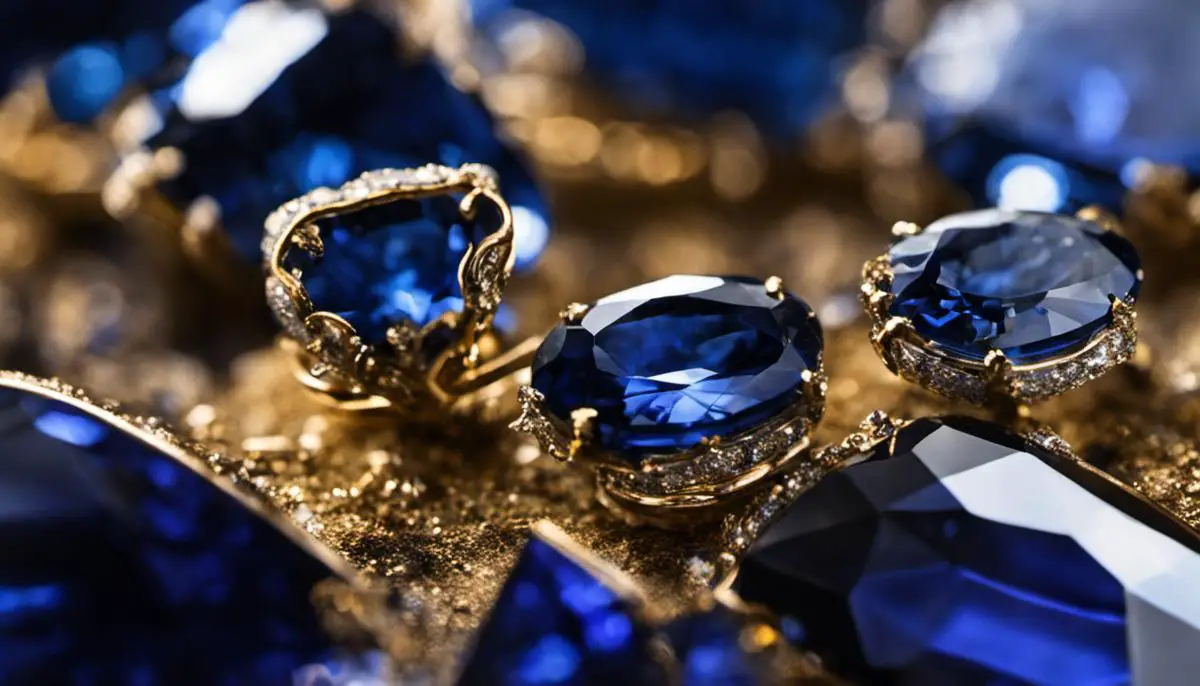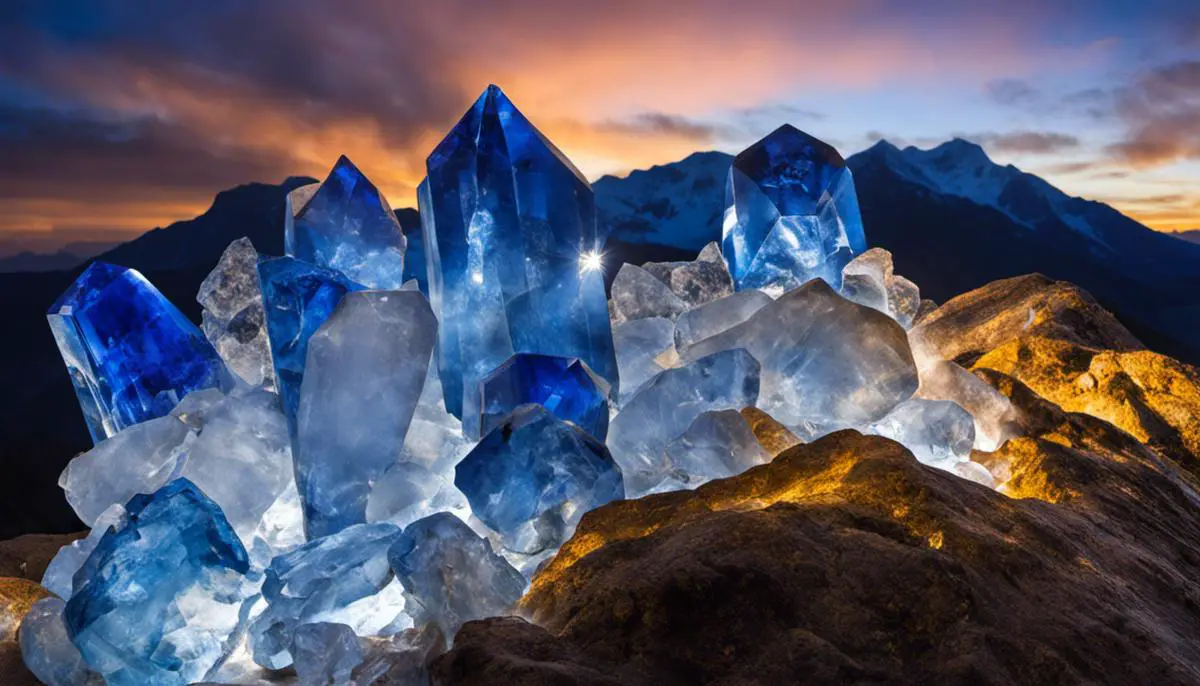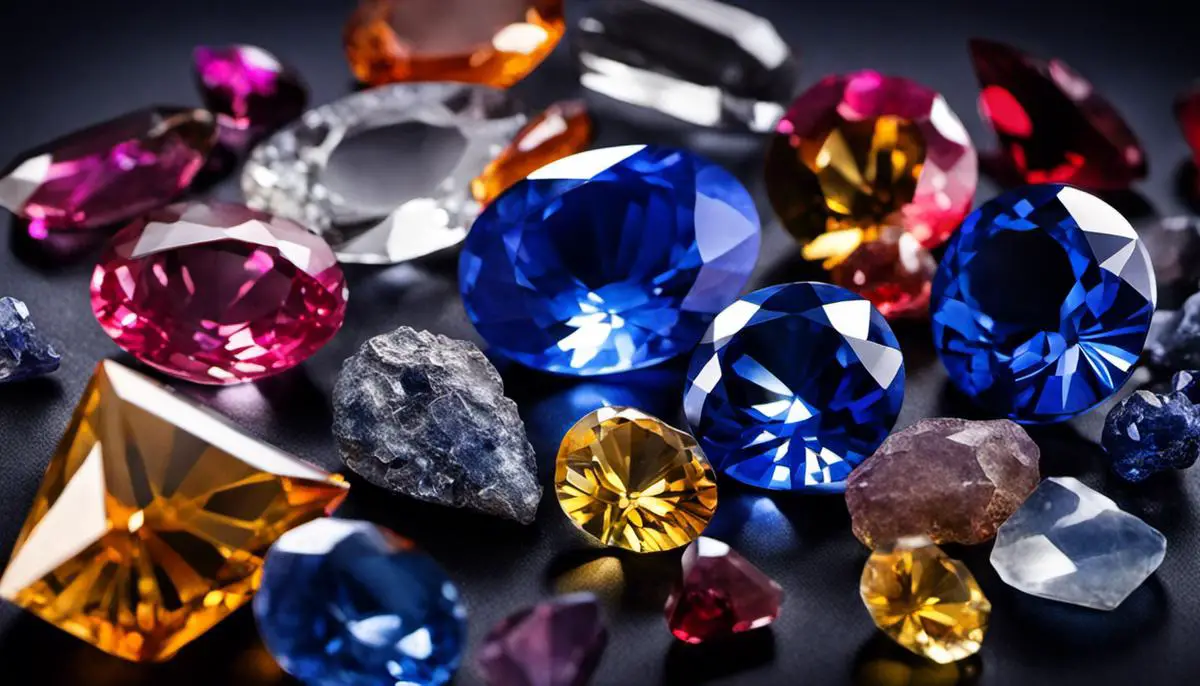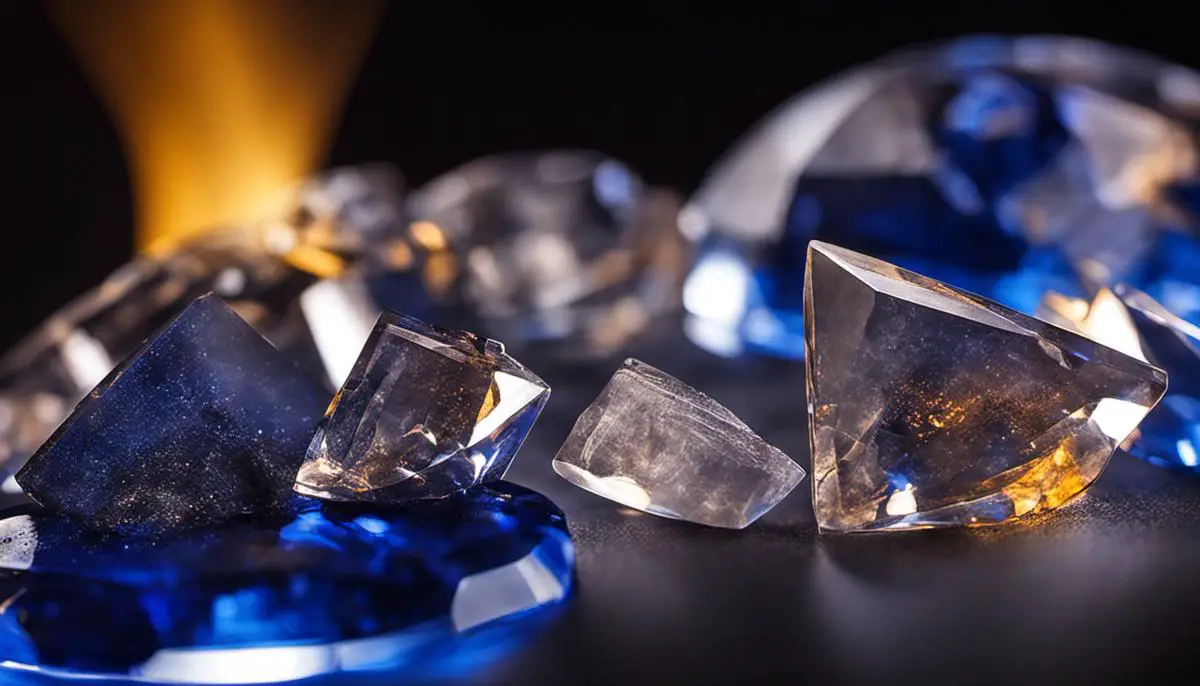In the intricate tapestry of the Earth’s geology, one gemstone outshines many others with its remarkable hardness, bright colors, and versatile applications: the sapphire crystal. Unearthed from the depths of the Earth and nurtured under intense heat and pressure, sapphires are crystalline forms of aluminum oxide richly hued by trace elements.
Though often seen solely for their aesthetic value in ornamental jewelry, a deeper delve into these lustrous gems uncovers a treasure trove of historic significance, symbolic meanings, and modern uses. Ranging from ancient cultures venerating their celestial blue hue, to modern industries harnessing their exceptional hardness, the tale of the sapphire is as diverse and rich as the stone itself.
Origin and Properties of Sapphire Crystals
Origin of Sapphire Crystals
Sapphire crystals are formed from a mineral known as corundum, which is essentially aluminum oxide. These crystals are typically formed in metamorphic rocks, including limestone and shale, under high temperature and pressure conditions. Certain regions of the world, such as parts of Africa, Asia, and Australia, are particularly rich in sapphires due to the geologic processes that have occurred there over millennia.
Sapphire crystals can also be created synthetically, a practice dating back to the late nineteenth century. Synthetic sapphires are made by applying extremely high heat and pressure to alumina powder. This process, known as the Verneuil process, allows for the formation of large, clear sapphire crystals that are often used in various industries, from jewelry to electronics.
Physical and Chemical Properties of Sapphire Crystals
In terms of physical properties, sapphire is best known for its hardness. On the Mohs scale of mineral hardness, which ranks minerals from 1 (softest) to 10 (hardest), sapphire scores a 9. This means it is one of the hardest naturally occurring substances, surpassed only by diamond. This makes sapphire an excellent choice for various applications, including watch faces, optical components, and semiconductor substrates.
Color variations in sapphires provide further points of interest. Although the most recognized color is blue, there can be a range of different colors depending on the presence of trace amounts of other elements within the crystal structure. The presence of iron and titanium can result in blue sapphires, while chromium can lead to pink or red sapphires, the latter of which are referred to as rubies.
Chemically, sapphire is a stable and inert material. This means it does not react or change easily when exposed to chemicals or radiation. This property, coupled with its hardness, leads to its use in various types of equipment and devices, especially in the electronics and optics industries.
The Symbolism and Utility of Sapphire Crystals
Sapphire crystals have been universally regarded as a symbol of wisdom, nobility, and divine favor throughout history. Cherished by ancient and medieval societies, these precious gems are believed to possess spiritual insights and protective properties. Across different cultures and religions, sapphires have retained their status as emblems of purity and power.
In contemporary contexts, sapphires, with their enduring allure and robustness, continue to serve as symbols of wisdom and royalty. Often seen in engagement rings and crowns, these beautiful blue gems not only symbolize a lasting bond but also convey a sense of regality and divine preference to the person wearing them.
Apart from their symbolic implications, sapphire crystals are also valued for their practical applications. The unique attributes of sapphires, such as their high durability, resistance to chemical alterations, and diverse color palette, make them an invaluable asset in various industries. Whether it’s being used in electronics, lasers, scratch-resistant watch covers, or high-end jewelry, the relevance of sapphire crystals transcends beyond symbolic meanings, extending to practical utility as well.

Historical Significance of Sapphire Crystals
Historical Noteworthiness of Sapphire Crystals
For millennia, sapphires have been revered as a gemstone that symbolizes nobility, truth, and passion. Derived from the Greek term ‘sappheiros’, originally associated with lapis lazuli, sapphires belong to the variety of the mineral corundum, with hardness surpassed only by diamonds.
Ancient Persian myths tell of the earth resting on a colossal sapphire, with its reflection casting the blue tint of the sky. Early adventurers and missionaries saw sapphires as protection against the unknown. Interestingly, Theophrastus, a renowned Greek historian living between 371 and 287 BC, reported that high priests often wore sapphire crystals, signifying these gems as an emblem of wisdom.
Sapphire Crystals Across Civilizations
Throughout history, civilizations around the world attributed high importance to sapphire crystals. In Ancient Rome, sapphires were worn by nobility as protection against envy and harm. They believed the stone had the ability to attract divine favor, and provide foreknowledge of hidden threats.
In the Middle Ages, sapphires held religious significance. Clergy wore sapphires to symbolize heaven, while common folk believed they attracted heavenly blessings. It was also believed that sapphire had medicinal properties and could heal ailments such as boils, eye diseases, and mental illnesses.
In the Indian subcontinent, Vedic astrology recommends sapphire for individuals with Capricorn and Aquarius zodiac signs. They are used to pacify the planet Saturn and are believed to bring wealth, health, and peace.
Associated Myths and Beliefs
Myths and legends about sapphire crystals are as mystical as the stone itself. In Medieval Europe, it was believed that if a sinful person wore a sapphire, it would harm them as punishment. In contrast, it was held that a sapphire would increase the wealth of the pure at heart.
The prophets of the Middle Ages reputed that sapphires endowed the wearer with the power to see into the future. Furthermore, common folklore upheld that sapphires could protect loved ones from harm and attract divine favor.
In Hindu mythology, the demon god Rahu consumed the nectar of immortality and was caught by the sun and moon gods. In response, Vishnu cut off Rahu’s head. The drops of blood that fell on earth turned into blue sapphires. Hence, many myths venerate the sapphire as a protective gemstone.
Summary
The enduring myths and beliefs about sapphires that have persisted through the ages underscore the significant cultural and historical value of these precious crystals. Their reputations for otherworldly properties and their esteemed status testify to their role as one of the most cherished gemstones of mankind.

Symbolic and Metaphysical Meanings of Sapphire Crystals
Interpreting the Symbolic Meanings of Sapphire Crystals
While sapphire crystals are widely recognized for their stunning blue hues, these remarkable gemstones actually come in a variety of colors, each carrying its own distinctive symbolic meaning. For instance, the blue sapphire, traditionally worn by royalty, symbolizes wisdom, virtue, prosperity, and piety. From ancient Greek and Roman monarchs to modern day aristocracy, it was believed that blue sapphires offered protection against malevolent spirits and jealousy.
Yellow sapphires, meanwhile, radiate a vibrant energy indicative of success and good fortune. This color is frequently associated with the wisdom of abundance, interpreted not just in terms of wealth, but in respect to intellectual richness and wisdom as well.
In contrast, pink sapphires epitomize resilience, courage, and emotional fortitude, empowering wearers to confidently stand in their truth. Then there are black sapphires, which are seen as powerful protectors. They represent strength, encourage confidence and are believed to dispel negative energies.
Sapphires in Various Cultures
Different cultures have different perspectives on sapphire crystals. In Hindu culture, yellow and blue sapphires are considered especially auspicious and are associated with the planets Jupiter and Saturn respectively. They are said to bring solace and balance in individuals’ lives.
In Christian iconography, the blue sapphire is renowned as a stone of wisdom and royalty, of prophecy and divine favor. It is thought to represent the purity of the soul and helps seeking divine truths.
Metaphysical Implications
The blue sapphire is also said to open the third eye to receive wisdom and insight, as well as the throat chakra, which allows one to communicate that vision to others. Additionally, its powerful energy is said to kindle the light of hope, protection, and strength.
Yellow Sapphire stimulates the intellect, helping to transform one’s ideas into reality. It boosts the solar plexus chakra, empowering personal power and a sense of abundance in various areas of life.
On the other hand, the Pink Sapphire provides emotional healing and assists in releasing past wounds. It works with the heart chakra, promoting love, forgiveness, and release of past traumas.
Sapphires in Crystal Healing
Sapphire crystals have been utilized in crystal healing for centuries, believed to bring about peace of mind, serenity, and spiritual enlightenment. Its tranquil energy is said to heal, calm and focus the mind, reducing negative and anxious thoughts.
Healers often use sapphires for their reputed ability to treat blood disorders, combat excessive bleeding and strengthen the walls of the veins. They are known as a stone of wisdom, learning, and mental acuity, enhancing creativity, and attracting prosperity and abundance.
A Close Look at Sapphire Crystals
Sapphire crystals are more than just beautiful gemstones; they have intriguing symbolic and metaphysical meanings attached to them. Over various periods and in numerous cultures, these vibrant crystals have been attributed with an assortment of beneficial impacts, spanning from promoting intellectual growth to fostering spiritual development. They also have properties perceived to contribute to physical recovery and emotional comfort. Known for their reputed capability to harmonize and align chakras, sapphire crystals have long been associated with wealth, wisdom, and resilience, making them invaluable in crystal-based healing sessions.

Modern Applications of Sapphire Crystals
Beyond Metaphysical: Sapphire Crystals in Electronics
Sapphire crystals have found their way into another domain—electronics. Today, they play a major role in the manufacture of components such as Integrated Circuits (ICs) and Radio Frequency Integrated Circuits (RFICs). Additionally, they’re fundamental in the development of Light Emitting Diodes (LEDs) and blue lasers. The preference for sapphire in these circumstances stems from its exceptional qualities like high thermal conductivity, resistance to radiation damage, and vast optical transmission range. These characteristics make sapphire crystals ideal for crafting long-lasting, robust electronic components.
Sapphire Crystals in Wafers
Another area where sapphire crystals have found use is in the production of semiconductor wafers. These thin slices of semiconductor material play an essential role in manufacturing integrated circuits. Sapphire provides the foundation for the GaN (gallium nitride) semiconductor devices. The exceptional heat resistance and dielectric constant of sapphire make it an ideal choice in this context.
Wristwatches and Sapphire Crystals
Sapphire crystals are a popular choice in the watchmaking industry due to their incredibly high scratch resistance. Sapphire stands at 9 on the Mohs scale, a measure of mineral hardness, which makes it the second hardest substance, just under diamond. This renders sapphire crystal virtually scratch-proof, except by diamonds or other sapphire crystals. As such, sapphire crystal is commonly used for the watch glass in high-end watches to guarantee a clear, scratch-free view of the time for many years.
Sapphire Crystals in Optics
Sapphire crystals are also used in optics and photonics due to their broad transmission range, from UV to mid-infrared wavelengths (0.2 – 5.5µm). This includes applications such as laser components, optics for high-energy applications, windows for spectroscopy and optics for radiation-resistant applications.
The Use of Sapphire Crystals in Telecommunications
Sapphire crystals have also found their place in the telecommunications industry. In mobile phones, sapphire crystals are often used in the construction of some internal components. For example, the insulators in Radio Frequency (RF) applications are typically made from single-crystal sapphire due to its dielectric properties. These sapphire components provide higher performance, enabling faster data transmission and superior signal quality.
Sapphire Crystals in Medical Devices
In the field of medicine, sapphire crystals are used in a variety of medical instruments due to their hardness and ability to transmit a broad wavelength spectrum. For instance, sapphire windows are used in endoscopes, laser scalpels, and surgical tools. In addition, due to its bio-compatibility, it’s used in prosthetics and implants.
Thus, the modern applications of sapphire crystals extend far beyond their aesthetic appeal in jewelry. Their physical and chemical properties make them an essential component in a host of industries, making our modern electronics, telecommunications, and medical devices possible.

Evoking curiosity and cherishing history and science, the stories of sapphire crystals make it evident that these gemstones are more than just their radiant blues or their variation in colors.
Their symbolism and metaphysical properties are deeply entrenched in the cultures of people from all over the world, and continue to influence contemporary interpretations. In the modern era, sapphires have not lost their allure; they have simply found new applications as sophisticated elements in technological devices and scientific research. As we venture forward, sapphire crystals promise to remain a topic of interest and exploration, continuously revealing new facets of their timeless beauty and practicality.




